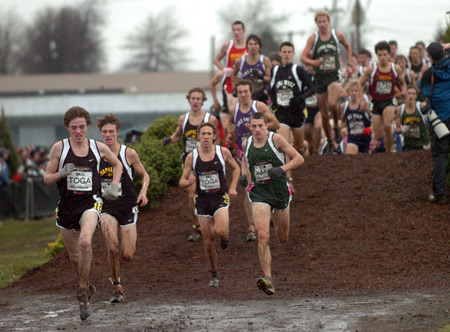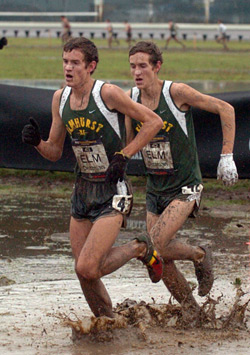 |
 |
 |
|
|
 |
 |
 |

Coach Kedge
Blog #4
by Adam Kedge
Albuquerque NM
| |
Adam Kedge, whose Albuquerque Academy Chargers returns to NTN Finals for the third time in 4 years (7th in 2006 and 10th in 2004),
describes the unique infield course at Portland Meadows race track.
How to run the NTN course - it's difficult but fair
"Somewhere in the 2nd K it seems like everyone is hauling. They are! This is nationals and that is how they all got here. Keep your cool and run your race."
It’s 4:30 AM Saturday morning and I can’t sleep. Despite being 1 week away from the National Championship race my mind is dreaming of NTN sugar-plums like a 4 year old on Christmas Eve. Around the team and with the alumni I am legendary for not being able to sleep the night before a big meet. Most of them know that it can last a few days depending on the magnitude of the meet. Well, it looks like we have a big one coming up. The next 7 days of racing anxiety will make my sleep patterns rival the week of state.
I have to realize that there are a countless number coaches around the country that are resting easy this morning with no races in their immediate future. Coaches would love to trade places with me and more importantly have their kids trade a relaxing weekend for 8 plane tickets to Portland.
In this week’s blog I am going to get a little technical and devote the majority of it to the NTN course and developing a race plan that would aid in team’s success.
Course overview
The course is generally flat with a few rolling hills. It runs 2 and ½ laps around the infield of Portland Meadows and the surface is a mixture of grass and dirt. Each lap has a series of 4 whoop-de-do hills that are no more than 12 feet in height. Each lap also has two sets of 3 hay bales. The hay bales are not stacked and spread out about 6 yards from each other. They do not pose a challenge and are negotiable for all runners. If the course was dry it would be firm and rank as easy to moderate in difficulty. The course has never been dry and looks like it is going to be wet as ever. Last winter there were places on the course where there was standing water that was 4 – 6 inches deep for long stretches. The mud makes the course run quite slow and I would rank the overall course when wet as difficult. Besides the rolling hills and the mud there are no other concerns with the course. The temperature will be cool but not cold enough that teams can’t run solely in their uniforms. There are no hairpin turns to negotiate or altitude to deal with. It is a fair course for all and those who make excuses are simply justifying a poor performance.
The 1st kilometer
The start is on the east side of Portland Meadows infield. It is wide enough for every team to line up 5 – 7 of their runners on the front line. It runs counterclockwise and nearly flat for the first 250 meters until there is a slight uphill and a sweeping left turn. The first turn is now legendary because of “the pile-up of 2006”.
What looked from the pictures to be about 15 – 20 people going down for a couple of seconds each has somehow turned into the excuse of the year. Some teams claim to have fallen 100’s of yards behind and had a countless number of runners go down. Around here we joke that some teams had as many as 8 runners fall down. The key on the first turn is what you do going into that first turn to stay out of trouble. My recommendation is to hold a good line to the first post. Last year most of the teams merged towards the center of the lead pack and made the turn far worse than it should have been. If your team is assigned a starting box in on the inside, stay inside. If you are lucky enough to start on the outside, then stay outside and go wide. Either way develop an open line of sight and anticipate that the pace is going to come to a near halt because of the combination of the slight uphill and the turn.
In kilometer 1 they course by-passes the hail bales so the runners don’t have to worry about going over them in a huge pack.
The rest of the 1st kilometer is a mad scramble with a lot of effort put into getting little gains for position. I recommend saving your energy for a little later in the race. You’ll need it. Settle in where you can keep your stride out.
The 2nd kilometer
The 2nd K starts around the finish area of the home stretch of Portland Meadows. It works it way around the first turn, back towards the infield, and then finishes up back at the start area. Included in the 2nd K will be “the lake” which is the muddiest area of the course with free standing water. Runners can try to go around the mud and try to avoid getting wet but it won’t work. Plow straight through it all and take your new spikes home in the hotel laundry bag.
As a runner you’ll come to the conclusion somewhere in the 2nd K that it seems like everyone is hauling. They are! This is nationals and that is how they all got here. Keep your cool and run your race.
After the lake are the Whoop-de-do hills. Do not put too much effort in the hills. They are not long enough to gain ground on anyone. Negotiating them is more about tempo and balance. We all have seen the video from 2005 where Nicole Blood tried to go through them a little too fast and stumbled. Watch the video and you can read her lips about her take on the hills.
After the first set of hills it is time to start racing. Keep the pedal down and maintain contact. I know your feet are wet and they feel heavy but you’re in the same boat as everyone else.
 |  | Whoop-de-do hills first time around when it is still very crowded.
| Go right through the water.
|
The 3rd kilometer
The 3rd K basically repeats the 1st K but runs a little lower on the bottom turn of the track. It is here where you go through your send set of hay bales. As a former steeplechaser here are a couple of pointers. Start by making sure you have a good line of sight to the bales. Then keep your head up and look through the hay bales instead of down at the one you are clearing. If at all possible step over the bales instead of stepping on them. That keeps your center of gravity lower and thus you use less energy. They are low enough that you do not have to worry about a dominant foot to hurdle them with or about proper hurdle form.
During the 3rd K you are going to realize that you can’t see the teammates that you are used to being around. Don’t freak out! They are close but so are another 50 kids that are all within about 30 meters at this point. Stay positive and hold things together.
The 4th kilometer
The 4th K retraces the 2nd K but things are stretched out more. The kids that thought that hanging out in the hotel hot tub for an hour would be cool to do now are nowhere to be found. The kids that thought that doing laps around the corridor of the hotel at midnight now look like they are running in quicksand. Too bad for them, we all hope they had fun because they won't make it back next year.
This K is critical from a momentum standpoint. Hopes are that you will be running well enough to be developing positive momentum. I refer to positive momentum a lot with my kids. That means passing instead of being passed. At minimum you have to be holding your position. Be tough.
During the 4th K, and the whole race for that matter, keep the turns tight and race the course as well as the people on the course. Don’t freak out if you are in 80th and you’ve never been in 80th place before. Beat those people you can beat.
The last kilometer
From near the start area one last time to the homestretch is crazy. The upper level places are likely decided by now but anything from 4th to about 104th is going to be won on guts. In XC we call it guts but in reality it is aerobic conditioning and running mechanics. The teams that kept true to their aerobic conditioning for a longer period of time will have the advantage. Being able to maintain running form is critical as well. Relax and push!
The final K is huge. NTN is a different beast. Every team here has depth and what used to be your team’s battle cry of “it takes 5 to win” is common place. Your team’s great 5th man is battling with 22 other teams’ great 5th man and 5 or 6 teams’ 6th and 7th man too. The teams that keep their cool over the last K are the ones that are going to be standing on the podium. Sprint, sprint, sprint, that one place may make a difference. Last fall there were 4 of us teams within 5 points of each other for a top-5 team spot. Sometimes 3 or 4 will cross the finish line in a second.
Good luck and I hope the overview helps.
Coach Kedge's Blog index |
|
|
|
|
 |
 |